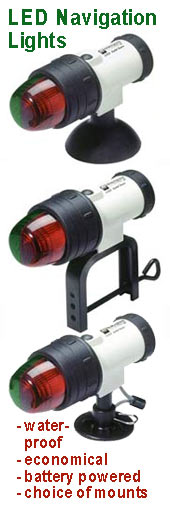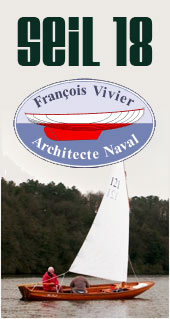
 Custom Search
|
|
| sails |
| plans |
| epoxy |
| rope/line |
| hardware |
| canoe/Kayak |
| sailmaking |
| materials |
| models |
| media |
| tools |
| gear |
 |
 |
| join |
| home |
| indexes |
| classifieds |
| calendar |
| archives |
| about |
| links |
| Join Duckworks Get free newsletter Comment on articles CLICK HERE |
|
|
| Out There |
by Paul Austin - Dallas, Texas - USA Reading Plans - Part Four |
 |
Part One - Part Two - Part Three - Part Four Now let's look at plans for a stitch and glue (SAG) pram, the style of boat which most of us build these days. Since the panels are cut to be stitched together, frames, ladder supports and strongbacks are not used. Usually a table or some other flat platform does just as well. The plans are simple, even though most designers of SAG include plenty of instructions. After you've done one SAG boat, you will have learned most of what you'll ever need to know. After you've done two SAG boats, you'll probably know 90% of what any set of instructions say. Still, you should read over every set of plans to see the sequence in which to build the design. Ideally the designer will use all of the plywood sheets. It helps if bottom sections are on the same sheet of plywood, the topsides are together, and the smaller pieces fill out the sheet. I don't mind buying a half-sheet of plywood, but I'd really rather not end up with too much of a 3rd sheet laying unused. I'll be working on study plans for the Ross Lillistone Alby, a 7 1/2 footer of great capacity. Whenever a boat is a v-bottom, it sinks deeper into the water. To keep a pram on top of the water the bottom has to be either wide or long. Alby is wide. I will give one opinion about SAG. This method enables a severe angle where plywood sheets come together. Such a severe angle would really strain a wood chine. So if you're going to have a SAG boat, take full advantage of this. Alby does with the deadrise bow. And if you don't feel confident about SAG the first time, try out a model of the same boat. It's actually kinda neat to have a little model of your own boat hanging from the rear view mirror (much cooler than dice).
Alby has 8 pages of plans—
The other details are on these pages, all drawn big enough for anyone to see. The key to good SAG plans are the instruction sheets, which guides you through the boat. Since the method is glue - not wood - we don't need to list different kinds of woods and their thicknesses. We need to cut panels and bevel them accurately. So, in an ironic way, the basic step of lofting has come back to us. To use a batten, measure accurately, bend and draw on the plywood is our new key. The issue here is the sequence in which the parts are put together. There are a few points to remember. One point is to measure from the same corner on every sheet. Most builders like to work around the piece from bottom left to right to up to back around to the starting point. Whatever you do, just do it the same way every time. A second point is that small boatbuilding is more of a mental habit than skill. If you can remember what you just did while you cut a piece and imagine what you'll be doing next, boatbuilding is for you. Builders get nervous when they momentarily forget what they just did, especially when it comes to cutting the good side of plywood. If you can remember you turned that sheet over to get the good side on the outside, then you don't have to turn this sheet over. If you can remember you beveled the right piece at an angle away from the center, then you can remember to bevel the left piece away from the center. When the two sheets are leaned together, the beveled edge will fit. The third point is that no matter what the promotional material says, SAG does not glue itself together. Corner pieces like knees are very important. So are the thwarts on this pram. In 18th and 19th century shipbuilding, bows were known to be the weakest part of the hull. With SAG, the bow has to be strong, too. SAG boats tend to get treated a bit rough in beaching and launching and jumping in. Pointed bows take the strain, as well as the bow transom angles on this pram.
Alby has its' two transoms whose top side is the same height above the waterline. This is wonderfully convenient for measuring and it has a neat level look on the water. I think a level sheer in an 8 footer looks good. Not only that, the waterline hits the hull right at two frames, so the hull will be stiff right where the water challenges the plywood. And the skeg does not dip below the bottom, protecting it somewhat. This will be handy when you beach the boat, bow first. You can scrape a skeg so much that it weakens the hull into leaks. Most designers will say put rub rails on the bottom sheets. The Lillistone plans are drawn to a beautifully fine degree with perfectly curved lines and plenty of measurements along 11 13/15" segments. I like the fact that the frame bevels are in measurements, not angles. It's so easy to get an angle line off, depending on the instrument you use. I say this with some small degree of experience at having to redraw lines.
This is what most SAG plans look like. I just made this up, but I hope it is typical of what you would see. Re all plans would have many dimensions printed right on these pages rather than a table of offsets. A good designers should have two things in mind. First, he should try to lay the pieces out which go together in the sequence he wants you to build it. Now this is not always possible, but the closer he can come to doing this the better for you. Topsides on the same plywood sheet with thwarts (if possible), bottom pieces on the same plywood sheet with rub rails, transoms and sail gear together. Second, he should have his plywood sheets laid out to be cut in the order he wants you to build the boat. Most SAG plans I've seen go from the bottom up. The two bottom sections are stitched together, then the topsides are stitched to them with spacers, and then the transoms are stitched in. The idea is that opening up SAG panels is easier than stitching the topsides and transoms together and then having to shove the topsides apart for the bottom pieces to fit. So in my fictitious plans, I've put the bottom on the first sheet of plywood, the topsides on the second with transoms. Paul is also publishing his books on Amazon. ***** |




